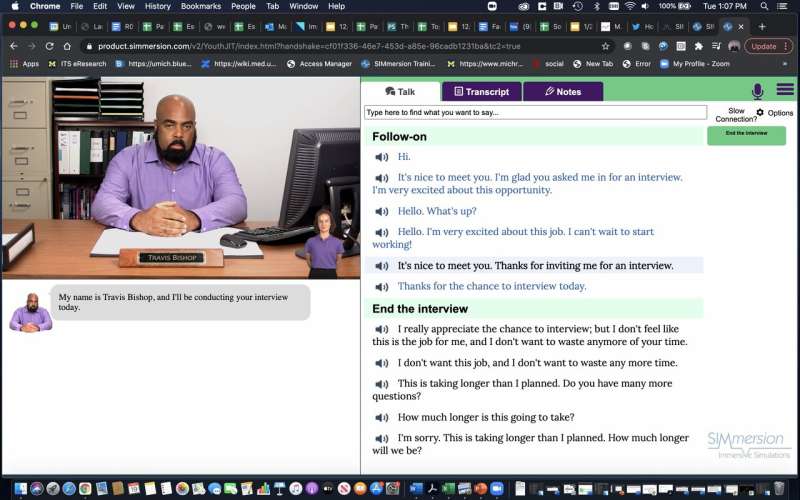Virtual training gives young adults with autism stronger interview skills to obtain jobs

Young adults with autism spectrum disorder boosted their interviewing skills using a virtual reality training program, according to a new University of Michigan study.
The virtual training sessions and separate preemployment assistance also significantly reduced anxiety and improved their access to jobs within six months compared to their counterparts who only received preemployment information.
Autistic transition-age individuals—between ages 16 to 26—often struggle with the interview process, a critical barrier to getting a job that leads to social and economic autonomy, said Matthew Smith, U-M associate professor of social work and the study’s lead author.
SIMmersion, a conversational training company, first developed virtual job interview training with Smith in 2012 to help adults with serious mental illness. Since then, Smith and SIMmersion redesigned the tool to specifically help youth and young adults with autism.
Recently, Smith and colleagues evaluated whether this virtual training program could be feasibly delivered in five high school special education settings. They wanted to learn if users reported better job interview skills and access to jobs while having less anxiety.
Trainees reviewed self-guided materials on how to find, prepare for, succeed in and follow up on job interviews. They also completed an online application for one of 14 jobs, such as cashier, clerical, customer service, food services, inventory, janitorial and web developer.
Trainees then practiced with a computerized simulator featuring two hiring managers at a fictional company. The youth repeatedly practiced virtual interviewing with feedback from an onscreen help coach and answered questions directly or redirected the conversation based on their needs (such as disclosing a disability).
Most of the 48 participants who did the virtual interviews for several hours successfully completed the tasks, in which interview questions were “easy,” “medium” and “hard.” They had better interviewing skills and 42% obtained jobs, compared to 30% of the 23 autistic transition-age youth who obtained jobs after receiving regular preemployment services.
Detroit resident Taishawn Johnson, 24, from Kennedy Learning Center/Southfield Public Schools, said the virtual session enabled him to speak more fluently, as well as understand what an interviewer would expect from him in an interview and possible job.
“It was definitely great for a learning experience as well as a confidence booster,” he said. “I think the program is really progressive and beneficial.”
Toledo resident Francisco Valle, 19, said the program enabled him to get a job at the Toledo Zoo.
“I feel without this program, I would’ve been very nervous and wouldn’t be able to do a successful interview,” he said. “It taught me different types of ways to make sure I don’t feel nervous and make my anxiety go through the roof.”
Teachers, such as Jocelyn Reese, a transition coordinator at the Lincoln Park ASD Program, confirmed they could feasibly implement the virtual tool within special education preemployment transition services.
“I liked that students can do the sessions independently,” she said. “The feedback I received from the staff and students was that it was user friendly, and the students really enjoyed doing it.”
Smith, who directs the U-M School of Social Work’s Level Up: Employment Skills Simulation Lab to support schools and other groups interested in learning best practices to deliver the tool, said the study showed that both the preemployment training service and virtual sessions proved to be effective together in improving the trainees’ overall interview skills—not only for jobs but also other opportunities.
In fact, the researchers found that nearly 17% of trainees who participated in the virtual training were able to transition from internships or volunteering into jobs at those locations.
Source: Read Full Article


